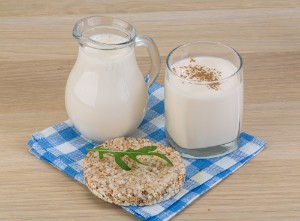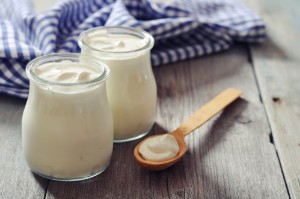What is the difference between fermented baked milk and kefir and what is more useful according to scientists
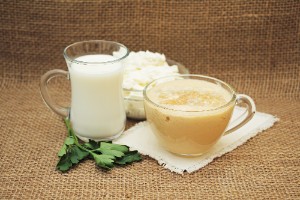 Ryazhenka and kefir are fermented dairy products that are beneficial to the human body.
Ryazhenka and kefir are fermented dairy products that are beneficial to the human body.
Both products improve the functioning of the stomach and intestines, strengthen the immune system, and reduce the risk of early cardiovascular mortality.
In this article, we will figure out what is the difference between kefir and ryazhenka, as well as which of them is more useful.
Content
What is more useful from the point of view of science?
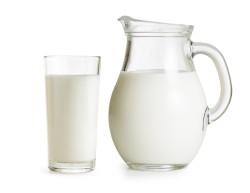
Due to its narrow distribution (only among Slavic peoples), ryazhenka does not have a strong scientific base and from the point of view of modern evidence-based medicine, it cannot be considered more useful than kefir.
But kefir is a very popular drink in the world with a powerful evidence base. Useful properties of kefir scientists from many countries have studied, many discoveries have been made.
The main advantages of kefir from a scientifically based point of view are considered to be:
- Powerful probiotic effect. Scientists claim that kefir contains a more diverse range and a larger volume of microorganisms that retain their vital activity in the intestinal lumen much longer (30-40 species versus only 2 in ryazhenka).
- Slowing down aging. According to Japanese scientists , kefir inhibits the course of chronic inflammation in the walls of the large intestine. It is this process that is associated with a high frequency of genetic mutations and shortening of telomeres during cell division in the body. There is also a direct relationship between the intensity of inflammatory bowel changes and the frequency of clinical manifestations of type II diabetes mellitus and Alzheimer's disease.
- Pronounced antibacterial properties. According to research data , kefir is able to block the reproduction of pathogens of salmonellosis and dysentery, inhibit the growth of E. coli. Prolonged intake of kefir prevents the development of gastritis associated with the persistence of helicobacter pylori.
6 medicinal properties of both products
 Although kefir is better researched, both drinks are powerful sources of probiotics
, affecting almost all systems of the human body:
Although kefir is better researched, both drinks are powerful sources of probiotics
, affecting almost all systems of the human body:
- Improving digestion . Drinks improve intestinal microbiocenosis: they inhibit the vital activity of pathogenic and opportunistic bacteria, increase the number of beneficial representatives of the microflora. Both products accelerate the breakdown and absorption of nutrients (they are also effective for lactose intolerance), normalize the motility of smooth muscles located in the intestinal walls. The products prevent the development of a number of dyspeptic functional disorders (nausea, belching, flatulence, constipation or diarrhea).
- Prevention of diseases of the gastrointestinal tract. The intake of fermented milk drinks has a beneficial effect on the course of any infectious and inflammatory (salmonellosis, dysentery, etc.) and autoimmune (Crohn's disease, ulcerative colitis) diseases. Fermented dairy products not only reduce the symptoms of the described disorders, but also contribute to the rapid onset of remission.
- Improving immunity . Systematic addition of probiotics to the diet leads to activation of local and general immune factors, acceleration of cell proliferation of the immune system. As a result, both local (ARVI, candidiasis of the skin, etc.) and generalized (sepsis) inflammatory processes are less common. They also prevent malfunctions of the protective system and the appearance of autoimmune abnormalities.
- Maintaining the strength of the skeleton. Both kefir and ryazhenka contain a number of valuable macronutrients (calcium, phosphorus, magnesium) and vitamins (B2, B12), which regulate the mineral composition of bone tissue, which leads to Bone strengthening . They provide reliable prevention of osteoporosis and fractures.
- Reducing the risk of mortality from cardiovascular diseases. Probiotic substances have a complex effect on all interrelated components of the metabolic syndrome: hypertension and symptomatic hypertension, obesity, gout, type II diabetes mellitus, lipid profile disorders and atherosclerosis. When taken, there is a decrease in blood pressure and blood sugar levels, normalization of body weight, glucose and insulin metabolism, and lipid profile (an increase in HDL, a decrease in TAG, LDL and total cholesterol). With the systematic addition of fermented dairy products to the diet, there is a lower incidence of such fatal complications from the circulatory system as myocardial infarction, thromboembolism of the branches of the pulmonary arteries, ischemic and hemorrhagic stroke.
- Maintaining mental health. Fermented dairy products improve mood and the general emotional background, Prevent stress and anxiety, increase tolerance to the effects of stressful factors. Probiotics also delay the development of Alzheimer's and Peak disease.
It is worth noting that many of the listed effects have fermented dairy products , such as yogurt, yogurt, varenets, katyk and others.
4 main differences
Kefir and fermented baked milk differ from each other in many ways: taste, color, consistency, production technology, etc.
Let's look at 5 main differences.
1. Origin
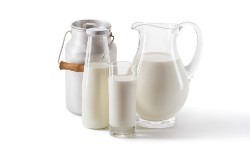 Ryazhenka is considered a national dish of Slavic cuisine. It is currently widespread in Ukraine, Russia and Belarus. The first mentions of the drink date back to the 15th-17th centuries.
Ryazhenka is considered a national dish of Slavic cuisine. It is currently widespread in Ukraine, Russia and Belarus. The first mentions of the drink date back to the 15th-17th centuries.
And kefir's homeland is the North Caucasus. The product gained popularity only at the beginning of the 20th century, although cases of its preparation and use were described at the turn of the 13th-14th centuries.
2. Organoleptic indicators
- Color. Kefir has a white or pale gray color, ryazhenka has a rich cream or light brown color. Such differences are due to the peculiarities of cooking each of them.
- Taste. Ryazhenka has a slightly acidic aftertaste, sometimes sweet. Kefir is always an acidic product with a slight taste of yeast.
- Consistency. Kefir's consistency is most often a liquid suitable only for drinking. Ryazhenka (depending on the fat content) can be either thick (creamy) or liquid.
3. Fat content and energy value
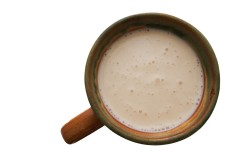 The standard fat content of kefir is 0%, 1.5%, 2.5% and 3.5%. The average calorie content is about 30-55 calories per 100 g of product.
The standard fat content of kefir is 0%, 1.5%, 2.5% and 3.5%. The average calorie content is about 30-55 calories per 100 g of product.
Ryazhenka (according to technological standards) can have a fat content of 2.5% to 6% and a calorie content of 58 to 100 calories.
Thus, ryazhenka is usually a more high-calorie product.
4. Production technology
Ryazhenka is obtained during fermentation melted milk. Fermentation occurs as a result of mixing lactic acid Bulgarian bacillus and thermophilic streptococcus. The duration of the process is from 3 to 6 hours, and the optimal temperature is around 40-45 degrees.
Kefir is made from milk by two types of fermentation at once – lactic acid and alcohol. The interaction occurs between a wide range of bacteria and yeast. As a result, there may be up to 30-40 stamps of microorganisms in the drink. The number of bacteria is also important – kefir has more of them than any other fermented milk drink.
Conclusion
Thus, both fermented milk products have a lot of useful qualities in relation to the human body. Due to the different production technologies, the products have different organoleptic properties and qualitative composition. The effect of kefir on humans is much better studied, so it is considered a more preferable dairy product.


